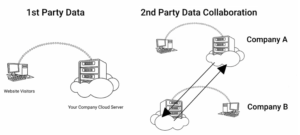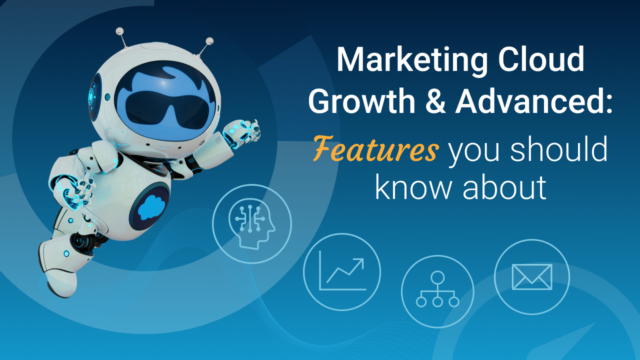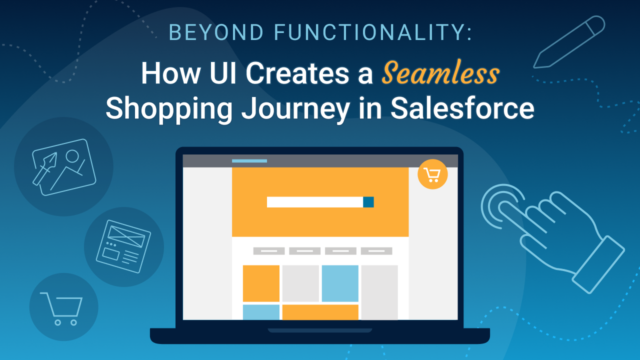A Shift Towards First and Second Party Data
Many predict that the removal of third party cookies from the web will change the entire advertising landscape. Some have even dubbed it the ‘cookie apocalypse’!
This article is for businesses and marketing professionals alike. It provides an overview of how forward-thinking companies plan to navigate the upcoming shift to a cookieless web. The following topics are covered:
- How third party cookies work
- What impact their removal will have on the advertising ecosystem
- Shifting to a reliance on first party and second party data
How Third Party Cookies Work
A third party cookie is a small piece of code that gets downloaded to a person’s computer when they perform a specific action on a website. For example, a potential customer might click a link on a business’ website. Out of self-interest, that business may have added code to the website in order to download cookies to the user’s computer.
There are many types of website cookies. Some are purely functional, such as first party cookies that facilitate webpage navigation and improve user experience (for example, a cookie to remember a language setting). Third party cookies are similar to first party cookies, but nominally, their function is to facilitate the collection of data about potential customers.
Since those cookies get stored on visitors’ computers, advertisers from other companies can then use those cookies via online publishers such as Facebook or Instagram to target display ads to people who fit certain demographic and behavioral profiles. Those profiles are put together by advertisers, who leverage the ability of online ad platforms to see their visitors’ cookies.
Third Party Cookie Removal and Its Impact
While third party cookies have always been the crux of how online publishers help advertisers target their ideal buyer persona, the increasing demand for greater consumer privacy is bringing that chapter to a close.
At the time of this writing, all three major browsers, Google Chrome, Safari and Firefox are implementing changes that will either diminish or completely block third party cookies.
In June, Google announced that they will completely block third party cookies on Chrome near the end of 2023, rather than their previous 2022 timeline. Their reasoning for the delay is that this gives online publishers and advertisers more time to prepare for this major shift.
“We need to move at a responsible pace, allowing sufficient time for public discussion on the right solutions and for publishers and the advertising industry to migrate their services.”
– Vinay Goel, Director of Privacy Engineering for Chrome
It should be noted that Google does plan to implement an ‘alternative’ to third party cookies in the future. The details of this alternative have yet to be publicly announced. However, it is unlikely that it will involve the same functionality that has allowed for ad targeting based on the individual profiles created by third party cookies.
The blocking of third party cookies from all major browsers will potentially transform the way brands engage with consumers in some of the following ways:
- Consumer data collection efforts will shift to first party data provided by companies’ customers instead of cookies created by third party websites.
- Brand partners will put more focus on second party data collaboration, where they may have similar audiences and can exchange consumer information.
- Companies will implement greater data collection transparency and customer control over what data can be used and when.
- Stakeholders, such as online publishers (social networks and other SSPs), may lose a large portion of their ad spend market, or even become obsolete.
In short, the removal of third party cookies from the web’s ecosystem will hinder the most common methods used for ad targeting. This means that many types of online advertising platforms will either need to adopt completely new models, or sink.
Companies that rely on these platforms will also need to formulate new strategies. They cannot simply hope that online advertising platforms will develop new technologies to circumvent this so-called ‘cookie apocalypse’. Companies will need to prepare themselves as the browsers adopt the new cookie blocking standard.
The Collection of First and Second Party Data
With the upcoming removal of third party cookies from web browsers, companies will increasingly rely on first and second party data for their advertising needs. It would not be prudent to wait until cookies become a thing of the past to make some changes.
The collection of first and second party data will be the proverbial open window that still exists after the door closes. In fact, it can be thought of as a real opportunity to gain greater customer trust, and perhaps even a means of overtaking a few unprepared competitors!
The Difference Between Third Party Cookies and First Party Data
Third party cookies reside on consumers’ browsers and computers. While cookies do hold data, this data is collected differently from first party data.
First party data can be collected in many ways; via online forms, comments within forums or chat, or other types of interaction on a website, or even in person. However, that data does not get implanted into visitors’ browsers or computers. And, they are ONLY collected by a first party; the company’s own website.
Third party cookies are a reference to third party companies’ cookies (the ones who implant the cookies). They are considered ‘third party’ data when other companies use this data for their own benefit, such as with targeting specific consumer segments in Facebook ads.
When first party data gets collected, it gets stored in a company’s database. Companies who use CRMs like Salesforce can easily leverage first party data for their advertising and retargeting needs. This is seen as being more transparent by website visitors, as most of that data gets input into forms and other fields of interest by the visitor. In other words, visitors have a clear understanding that their data is being collected.
The Increasing Importance of Second Party Data Collaboration
When brand partners trade information around their target buyer personas, they can maximize their ad spend.
Many believe that this will become the norm, as ad targeting becomes more difficult without third party cookies. Companies that have similar buyer personas can partner up with each other and share their customer data. This ‘trade’ of information is tantamount to creating ‘lookalike’ audiences on today’s online advertising platforms.
This trade between brand partners can be effective at minimizing costs and the time it can take to collect consumer data. It is not yet clear exactly how brand partners will put this all into practice.
In Closing
This shift in how advertisers collect information will ultimately transform the way we think about online marketing. However, not all online advertising methods will become obsolete, and some will be more affected by this than others.
Where To Go From Here
Stay tuned for Part 2 of ‘Preparing for the Cookieless Web’.
Have Questions? Find out more by reaching out to CloudKettle for a consultation with one of our marketing experts. Not ready to speak with a consultant? We have many resources to share. Sign up for our newsletter!




